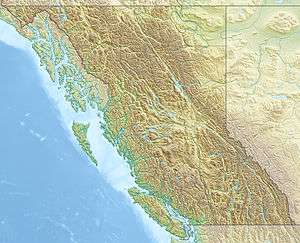Mount Judge Howay
| Mount Judge Howay | |
|---|---|
 Mount Judge Howay British Columbia | |
| Highest point | |
| Elevation | 2,262 m (7,421 ft) [1] |
| Prominence | 1,627 m (5,338 ft) [1][2] |
| Listing | |
| Coordinates | 49°30′25″N 122°19′18″W / 49.50694°N 122.32167°WCoordinates: 49°30′25″N 122°19′18″W / 49.50694°N 122.32167°W [1] |
| Geography | |
| Location | Lower Mainland, British Columbia, Canada |
| Parent range | Garibaldi Ranges |
| Topo map | NTS 92G/09 |
| Climbing | |
| First ascent | 1921 Tom Fyles; E. Fuller; H. O'Conner |
| Easiest route | navigation, technical rock climbing |
Mount Judge Howay, originally the Snow Peaks (a term which included Mount Robie Reid), is a distinctive twin summit located 10 km (6 mi) from the Central Fraser Valley and, close up, the north end of Stave Lake. Being one of the highest peaks in the region, it is visible from many of the peaks around Vancouver, British Columbia. It is on the eastern side of Golden Ears Provincial Park.
Name
Mount Judge Howay is named for Frederic W. Howay, a noted jurist and judge primarily known for being an authority on the history of British Columbia. Just to the southwest, Mount Robie Reid commemorates his lifelong colleague in law and history, Robie Lewis Reid.
Access
Due to its remote location and complicated topography, it is a very difficult peak to climb. To approach it from the southeast requires a canoe to get to the head of the lake, an approach on deactivated logging roads, a ford of the Stave River, climbing through steep Pacific Coast rainforest while orienteering through cliff bands.
See also
References
- 1 2 3 "British Columbia and Alberta: The Ultra-Prominence Page". Peaklist.org. Retrieved 4 November 2012.
- ↑ "Mount Judge Howay". Peakbagger.com. Retrieved 4 November 2012.
Sources
- Barnard, Kobus (1989). "South Peak of Mt. Judge Howay - Kindl Buttress". Canadian Alpine Journal.
- Barnard, Kobus (1990). "Mount Rexford Traverse and Judge Howay South Face". Canadian Alpine Journal.
- Barnard, Kobus (1993). "Judge Howay Revisited..ted..ted". Canadian Alpine Journal.
External links
- "Mount Judge Howay". Bivouac.com.
- "Mount Judge Howay". BC Geographical Names.